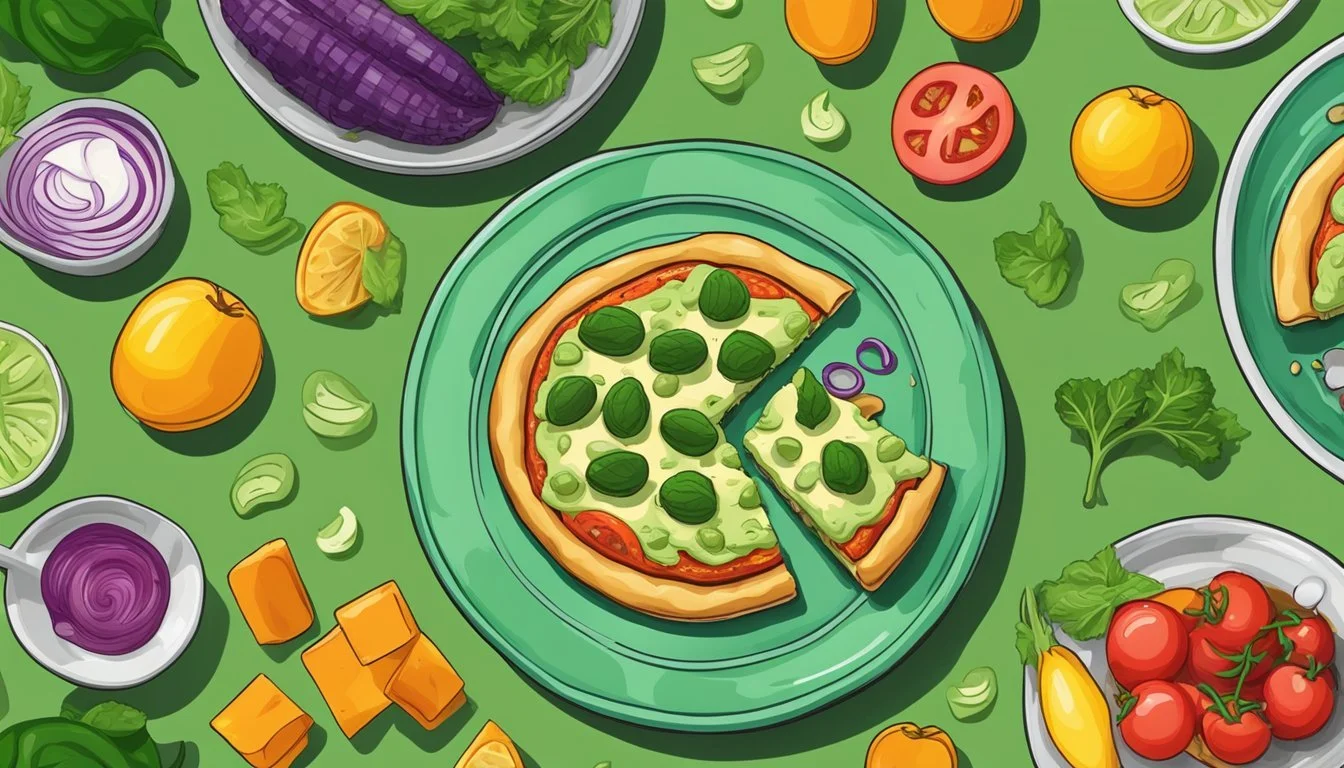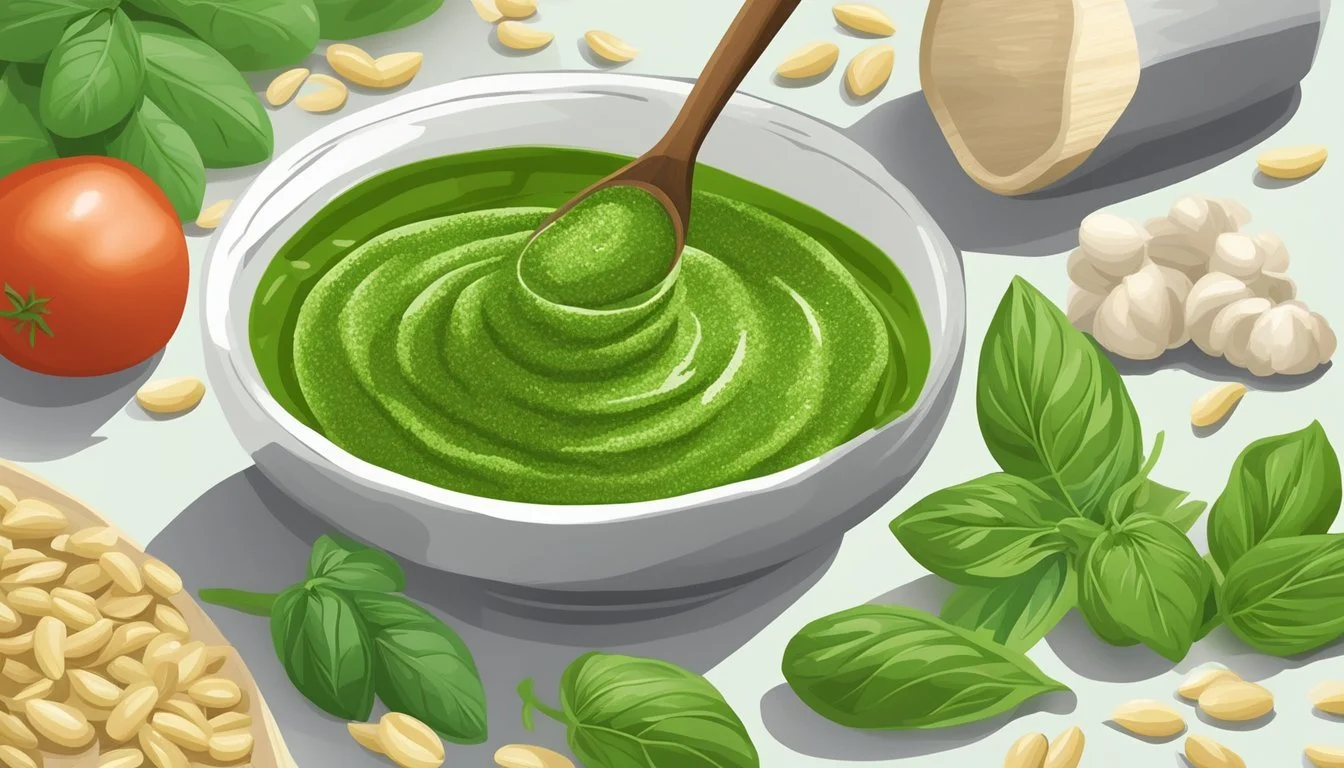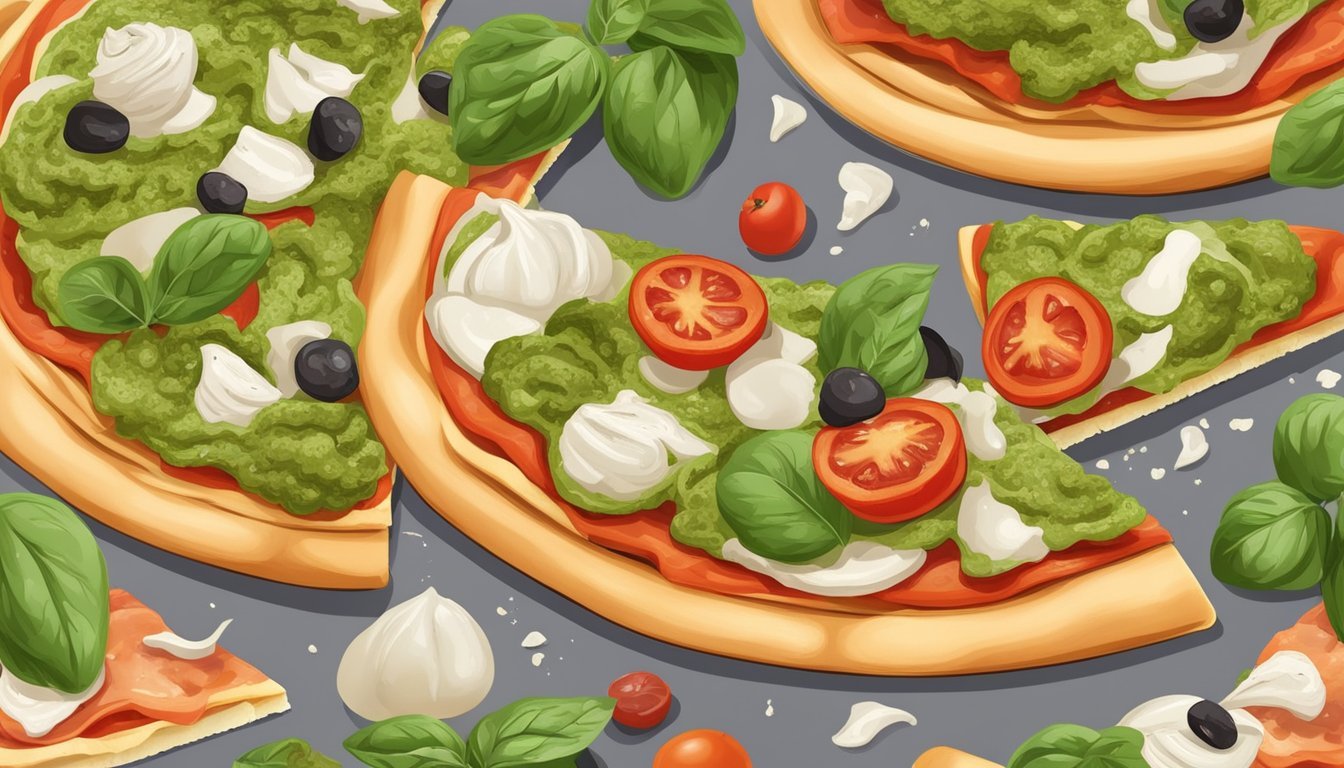Is Pesto Pizza Vegan?
Unveiling the Truth Behind the Toppings
Determining whether pesto pizza (What wine goes well with pizza?) is vegan requires a thorough understanding of its ingredients. Pesto, a sauce originating from Italy, traditionally consists of basil, garlic, pine nuts (What wine goes well with nuts?), Parmesan cheese, and olive oil. On a classic pesto pizza, this herby mixture is spread over pizza dough, often topped with sliced tomatoes (What wine goes well with tomatoes?) and cheese, and baked. Since conventional pesto contains Parmesan, which is made from animal milk, and pizza often includes mozzarella cheese, a traditional pesto pizza is not vegan.
However, with the growing demand for plant-based alternatives, vegan pesto pizza has become increasingly popular. Vegan pesto substitutes Parmesan with nutritional yeast or vegan cheese, providing a similar umami flavor and cheesy texture. For the pizza itself, plant-based cheeses made from nuts like cashews or almonds or commercial vegan cheese alternatives can be used. Moreover, the pizza dough and tomato sauce are typically vegan, making them suitable for a vegan pesto pizza with the right adjustments.
To craft a vegan pesto pizza, chefs spread vegan pesto sauce over pizza dough and layer with various plant-based toppings like roasted tomatoes, spinach (What wine goes well with spinach?), artichokes, (What wine goes well with artichokes?) and vegan mozzarella. When baked correctly, the pizza boasts a golden-brown crust with melted cheese, combining the rich flavors of pesto with the comfort of a classic pizza, all while adhering to vegan dietary preferences.
Understanding Pesto Pizza
Pesto pizza merges the bold flavors of pesto sauce with the classic canvas of pizza dough. It's a variation that's adaptable to various dietary preferences, including veganism, with careful selection of ingredients.
Composition of Pesto
Pesto is a sauce that traditionally blends several key components:
Basil: The foundational herb that gives pesto its characteristic flavor and green color.
Pine Nuts: They provide a nutty texture and taste, though other nuts or seeds can be used.
Olive Oil: It acts as a liquid base to create a spreadable sauce.
Garlic: This adds a sharp and distinct taste.
Salt: Enhances the overall flavor profile of the pesto.
These ingredients are typically combined in a food processor until they form a smooth, spreadable sauce.
Traditional Pesto Ingredients
In classical pesto, known as Pesto alla Genovese, the components include:
Fresh basil leaves
Pine nuts
Garlic cloves
Olive oil
Salt
Although traditionally made with Parmesan cheese, pesto for a vegan pizza would omit the cheese or substitute it with a plant-based alternative to maintain the vegan integrity of the dish. Consequently, nutritional yeast is often used to mimic the savory, cheesy flavor.
Veganism and Pizza
Pizza is a beloved dish worldwide, and adapting it to a vegan diet involves swapping traditional ingredients for plant-based alternatives. The focus is on preserving the essence of pizza while aligning it with the principles of veganism.
Principles of Vegan Diet
The vegan diet excludes all forms of animal products and byproducts. For pizza to be vegan, every ingredient from the crust to the toppings must be free of animal involvement. This includes cheese, which is a staple topping on traditional pizzas, and other dairy-based products such as some variations of pesto, which often contains Parmesan cheese. In the context of pesto pizza, ensuring that the pesto is made without cheese or other non-vegan additives is crucial.
Vegan Pizza Variants
Vegan Cheese: Vegan pizzas often incorporate cheese alternatives made from nuts, soy, or other plant-based sources. Key varieties include:
Vegan Mozzarella: Typically used for its melting properties, it's made from oils, tapioca starch, and nut or soy bases.
Vegan Parmesan: Comes in shredded or powdered form and is typically made using nuts like cashews, nutritional yeast, and seasoning.
Vegan Pesto: Traditional pesto is made with basil, garlic, olive oil, pine nuts, and Parmesan cheese. To adapt this to the vegan diet, nutritional yeast or vegan parmesan can be used as a cheese substitute. Pumpkin seeds or walnuts could replace pine nuts.
Vegan Pizza Variants: With the elimination of dairy and meat products, vegan pizza embraces a range of plant-based toppings.
Ingredient Role Examples Base Foundation Dough made without dairy or eggs Spread Flavor, moisture Vegan pesto, tomato sauce Cheese Texture, richness Vegan mozzarella, vegan ricotta Toppings Variety, nutrients Vegetables, artichokes, vegan proteins
Incorporating these ingredients allows for a wide variety of vegan pizzas, from Pesto Pizza with Roasted Tomato to Mediterranean Pesto Pizza, ensuring that the integrity of the classic flavors is maintained while adhering to vegan principles.
Making Vegan Pesto
Crafting a delicious vegan pesto is straightforward and requires swapping out traditional Parmesan for plant-based alternatives to adhere to a vegan diet. The essence of vegan pesto lies in its fresh ingredients and simple preparation method.
Vegan Pesto Ingredients
The foundational ingredient for vegan pesto is basil, offering a fresh and aromatic profile. One substitutes Parmesan with nutritional yeast to replicate the cheesy flavor while adhering to vegan constraints. For the necessary fats, options include pine nuts, cashews, or walnuts, which should be fresh and unsalted. The recipe requires olive oil for a smooth consistency and lemon juice for a bright, citrus note. Raw garlic adds a pungent kick, and a pinch of salt is necessary to enhance all flavors. Occasionally, miso may be used to add depth and umami.
Vegan Pesto Base:
Basil: Fresh leaves
Nutritional yeast: For a cheesy flavor
Nuts: Pine nuts, cashews, or walnuts
Olive Oil: Extra-virgin preferred
Lemon Juice: Freshly squeezed
Garlic: Peeled
Salt: To taste
Miso (optional): For added umami
Preparation of Vegan Pesto
To prepare vegan pesto, one begins by placing the basil, nuts, garlic, lemon juice, nutritional yeast, and salt into a food processor. They should blend these ingredients until they achieve a coarse paste. While blending, olive oil is poured in gradually to emulsify the ingredients, creating a creamy texture. One must scrape down the sides occasionally to ensure even integration of the ingredients. If a thinner consistency is desired, water can be added. For enhanced flavor, a small amount of miso could be incorporated, if using. Vegan pesto can be used immediately or stored in the fridge, covered with a thin layer of olive oil to preserve its freshness.
Creating the Pizza Base
The foundation of a great vegan pesto pizza is the crust. An exceptional pizza base is achieved by selecting the appropriate flour and carefully kneading and baking the dough.
Choosing the Right Flour
When making homemade pizza dough, the choice of flour can significantly influence the texture and taste of the pizza base. For a classic pizza crust, all-purpose flour is a reliable choice due to its moderate protein content, which offers a balance of chewiness and structure. Those seeking a healthier alternative can opt for whole wheat flour, understanding it will result in a denser dough.
All-purpose flour: well-balanced protein content
Whole wheat flour: healthier, denser dough
Kneading and Baking Pizza Dough
Kneading the dough is a critical step in developing gluten, which gives the pizza crust its elasticity and chewy texture. The dough should be kneaded until it is smooth and elastic.
Active dry yeast should be dissolved in warm water to activate it before combining with flour.
Mix the ingredients until a rough ball forms, then knead for about 5-10 minutes.
Allow the dough to rise at room temperature until it doubles in size.
Once the dough has risen, it should be punched down and can then be shaped into balls for individual pizzas.
To bake the pizza dough:
Preheat the oven as hot as possible, typically between 450-500°F (232-260°C).
Roll out the dough to the desired thickness and transfer it onto a pizza stone or a baking sheet.
Bake the dough for a few minutes before applying the toppings. This initial baking, or "par-baking," helps to prevent a soggy crust.
Assembling the Vegan Pesto Pizza
Assembling a vegan pesto pizza requires careful layering of ingredients and attention to baking techniques to ensure a delicious, crispy result that adheres to vegan dietary preferences.
Layering Ingredients
When building the vegan pesto pizza, bakers should begin with their dough placed on a pizza stone or a baking sheet lined with parchment paper. The dough should be rolled or stretched into the desired shape. Vegan pesto is then spread onto the dough, leaving a border around the edges to allow for crust development. The quantity of pesto is to one's preference, but typically a thin layer is sufficient to flavor the pizza without making it soggy.
Next, vegan cheese, which may include varieties like store-bought vegan mozzarella or homemade almond ricotta, is distributed evenly across the pizza. If almond ricotta is used, teaspoon-sized dots are placed around the pizza to ensure an even melt. One can hand-tear or slice the cheese depending on the desired coverage and texture.
In addition to pesto and vegan cheese, additional toppings such as artichokes, cherry tomatoes, roasted red peppers, spinach, and red onion can be added according to personal preference. It's important to arrange these toppings in an even manner for balanced flavor and to ensure even cooking.
Baking Techniques
Once the pizza is assembled, the oven should be preheated to the highest setting, which allows the pizza to cook quickly and achieve a crispy crust. If one is using a pizza stone, it should be placed in the oven ahead of time to preheat as well, creating an ideal cooking surface.
The pizza is then transferred into the oven and baked until the crust is golden brown and the vegan cheese has melted, which generally takes about 10 to 15 minutes depending on the oven and thickness of the dough. It's not recommended to use a microwave for baking the pizza as it will not yield a crispy crust.
Due to the delicate nature of some vegan cheeses and the potential for variation in oven temperatures, bakers should monitor the pizza closely as it cooks to avoid burning. Once finished, the pizza should be removed from the oven using a pizza paddle or similar utensil and allowed to cool slightly before slicing. This ensures the toppings set and the flavors meld perfectly.
Topping Variations
When crafting a vegan pesto pizza, the selection of toppings can elevate the dish from simple to sublime. The following subsections will explore classic combinations that have stood the test of time and unique ideas for those looking to experiment with new flavors.
Classic Topping Combinations
Margherita Pesto Pizza:
Sauce: Pesto
Cheese: Vegan mozzarella
Toppings:
Fresh basil leaves
Sliced tomatoes
Drizzle: Balsamic glaze
Mediterranean Pesto Pizza:
Sauce: Pesto
Cheese: Vegan mozzarella or almond ricotta
Toppings:
Spinach
Artichoke hearts (marinated for extra flavor)
Roasted red peppers
Red onion
Cherry tomatoes
Seasoning: A pinch of red pepper flakes
Unique Topping Ideas
Arugula and Roasted Tomato Pesto Pizza:
Sauce: Pumpkin seed pesto or classic basil pesto
Toppings:
Arugula
Roasted tomatoes (for a concentrated flavor)
Thinly sliced red onion
Optional: A drizzle of balsamic glaze to add a sweet and tangy finish
Nutritional Information
When considering the nutritional information of vegan pesto pizza, the primary focus is on its caloric and macronutrient content, as well as the presence of key vitamins and minerals that are part of a balanced diet.
Caloric and Macronutrient Breakdown
Calories: The caloric value of a vegan pesto pizza can vary based on the specific ingredients used but typically ranges from 200 to 300 calories per slice.
Macronutrients:
Protein: The protein content largely depends on the toppings and whether a vegan cheese substitute is used. It's estimated at around 5-10 grams per slice.
Fat: Pesto is primarily made from nuts and oil, so a slice may contain between 10-15 grams of fat, primarily healthy unsaturated fats.
Carbohydrates: On average, a slice might have anywhere from 25-35 grams of carbohydrates, largely due to the pizza dough and any additional vegetable toppings.
Nutrient Amount per slice (approx.) Calories 200-300 Protein 5-10g Fat 10-15g Carbohydrates 25-35g
Vitamins and Minerals
Vitamins:
Vitamin A: Ingredient such as spinach are rich in vitamin A, contributing to the overall nutritional value.
Vitamin C: Depending on the vegetable toppings, these can add a source of vitamin C, especially if fresh tomatoes are included.
Minerals:
Calcium: Vegan cheese substitutes often include calcium, ensuring the pizza contributes to daily calcium needs.
Iron: Some vegan pizza toppings, (What wine goes well with pizza toppings?) such as spinach and certain vegan meats, can be good sources of iron.
Fiber: Fiber content is inherently present due to vegetables and is sometimes enhanced with whole grain dough options.
Sodium: The amount of sodium in a slice is often dependent on the pesto and cheese used, with potential variations based on individual recipes.
Vitamin/Mineral Source Vitamin A Spinach, other green vegetables Vitamin C Tomatoes, bell peppers Calcium Vegan cheese substitute Iron Spinach, certain vegan meats Fiber Vegetables, whole grain dough Sodium Pesto, vegan cheese, dough
It's important to read labels or inquire about specific nutritional information when purchasing or ordering a vegan pesto pizza, as individual ingredients and portion sizes will significantly influence the nutritional profile.
Serving and Storage
The enjoyment of vegan pesto pizza is maximized when served at the right temperature and stored properly to maintain its freshness.
Optimal Serving Conditions
After preparing vegan pesto pizza, it should be served immediately to enjoy the blend of flavors and the crispness of the crust. Ideally, the pizza is best enjoyed when it's heated to a temperature where the vegan cheese has melted adequately, and the crust edges are lightly golden. It's also beneficial to season with a dash of salt and pepper, or a squeeze of lemon to enhance the flavors right before serving.
Preserving Leftovers
Storing leftover pizza properly is crucial for maintaining its taste and texture. The pizza should be cooled to room temperature before placing it into an airtight container and storing it in the fridge to keep it fresh. To reheat, one may heat the pizza in an oven at 350 degrees Fahrenheit until it is thoroughly warmed. Leftovers are typically best when consumed within 2-3 days to ensure the best quality. When reheating, avoid using a microwave as it can make the crust soggy.
Conclusion
A vegan pesto pizza is a delightful twist on the classic Italian dish. Pesto, traditionally made with basil, garlic, pine nuts, Parmesan cheese, and olive oil, requires modification to fit a vegan diet. Vegan pesto substitutes Parmesan with nutritional yeast or vegan cheese, ensuring the signature savory flavor is retained.
Creating a homemade vegan pesto pizza involves selecting a vegan-friendly pizza dough, spreading an even layer of vegan pesto, and topping with plant-based cheese and desired vegetables. For an authentic Italian experience, additional toppings such as sun-dried tomatoes, artichoke hearts, and olives (What wine goes well with olives?) can be included.
When baking, it is crucial to preheat the oven to ensure a crisp crust. Suggested temperatures range from 350 degrees F to a higher 475 degrees F, with variations depending on the recipe and the chef's preference.
Lastly, proper storage extends the life of vegan pesto pizza leftovers. It is recommended to store in an airtight container, refrigerated, for 3 to 5 days.
In essence, the versatility of vegan pesto pizza allows for creativity in the kitchen, making it a well-established favorite among both vegans and those exploring plant-based cuisine.








